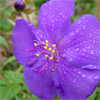
Lyonia 7(2) 2004 - Conservation of Biological and Cultural Diversity in the Andes and the Amazon Basin - Ethnobotany, Resource Use and Zoology - December 2004
Scientists widely agree that species extinction has heavily accelerated in the last decades. The majority of the worlds species are found in tropical forests, covering a mere ten percent of the planets surface. A grave problem for the conservation of diversity is the still very fragmentary knowledge of the ecology of most species.
The Andes and the Amazon Basin represent one of the most important Biodiversity-Hotspots on Earth. Attempts of sustainable management and conservation must integrate local communities and their traditional knowledge. Management decisions need to include the high importance of natural resources in providing building materials, food and medicines for rural as well as urbanized communities. The traditional use of forest resources, particularly of non-timber products like medicinal plants, has deep roots not only in indigenous communities, but is practiced in a wide section of society. The use of medicinal herbs is often an economically inevitable alternative to expensive western medicine. The base knowledge of this traditional use is passed from one generation to the next. Especially the medical use represents a highly dynamic, always evolving process, where new knowledge is constantly being obtained, and linked to traditional practices.
An increased emphasis is being placed en possible economic benefits especially of the medicinal use of tropical forest products instead of pure timber harvesting, an approach particularly appealing to countries with difficult economic conditions. Most research efforts, due to lack of manpower, time end resources, focus only on either biodiversity assessments or ethnobotanical inventories, or try to implement management and use measures without having a sound scientific base to do so. Often the needs of the local populations, e.g. their dependency on plant resources for health care are entirely ignored.
In 2001, the 1. Congress of Conservation of Biological and Cultural Diversity in the Andes and the Amazon Basin in Cusco, Peru, attempted to provide a platform to bridge the existing gap between Scientists, Non Governmental Organizations, Indigenous Populations and Governmental Agencies.
The 2. Congress of this topic was held in Loja, Ecuador in 2003.
Lyonia has dedicated its 2004 issues to the publication of the most important contributions to the Loja congress.
Volumes 6 (1-2) contain papers on the Biodiversity Conservation and Management.
Volume 7 (1) deals with Flora and Vegetation of the Region
Volume 7 (2) focuses on Ethnobotany, Resource use and Zoology
